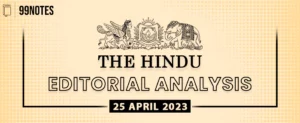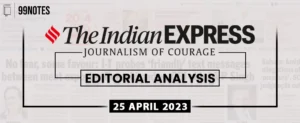25 April 2024 : Daily Current Affairs
Daily Current Affairs
25-April -2024- Top News of the Day
1. No forests or animals will be left if human-wildlife conflicts continue: SC
|
Topic: GS3 – Environment and Ecology – Conservations The topic reflects UPSC’s focus on environmental governance, wildlife conservation, and balancing rights, crucial for understanding policy-making and legal frameworks. |
| Context: |
| ● The Supreme Court addresses human-wildlife conflicts in Assam’s Pobitora wildlife sanctuary, emphasizing the need for balance between human rights and wildlife protection. |
Additional information on this news:
- The Supreme Court highlighted the danger human-wildlife conflicts pose to forests and wildlife.
- Justice B.R. Gavai emphasized the need to strike a balance between the rights of both stakeholders.
- The case concerned the demarcation of boundaries of Assam’s Pobitora wildlife sanctuary and rights of villagers.
- The Assam government formed a special committee chaired by the Chief Secretary (Forests) to survey and suggest alterations in sanctuary boundaries.
- The committee includes representation from wildlife authorities.
- State proposals will be reviewed by the National Board of Wildlife and the Supreme Court.
- The court ordered inclusion of wildlife representatives in the special committee.
- Proposed changes aim to address both human settlements and growing rhinoceros population.
- Justice Gavai stressed considering the human aspect alongside environmental concerns.
- On March 13, the apex court stayed Assam government’s decision to denotify the Pobitora wildlife sanctuary.
| Human-Wildlife Conflicts |
|
Reasons:
Way Forward:
|
| PYQ: Identify and discuss the factors responsible for diversity of natural vegetation in India. Assess the significance of wildlife sanctuaries in rain forest regions of India. (250 words/15m) (UPSC CSE (M) GS-1 2023) |
| Practice Question: Discuss the factors contributing to human-wildlife conflicts and propose strategies for mitigation. How can effective policy interventions and community engagement ensure sustainable coexistence between humans and wildlife? (250 Words /15 marks) |
2. On the National Clean Air Programme
|
Topic: GS2 – Governance – Government Policies GS3 – Environment – Environmental pollution and degradation Understanding the challenges and strategies of India’s National Clean Air Programme is crucial for environmental governance and sustainability. |
| Context: |
| ● The news is about the challenges faced in implementing India’s National Clean Air Programme (NCAP) aimed at reducing atmospheric particulate matter concentration. |
Introduction:
- The National Clean Air Programme (NCAP) was launched by the Indian government in 2019 to reduce atmospheric particulate matter (PM) concentration.
- Initially aimed at cutting PM levels by 20-30% by 2024, the target was later revised to 40% by 2026.
Challenges in NCAP Implementation:
- Inconsistent implementation of Clean Air Action Plans (CAAPs) despite proactive submission by most cities.
- Average utilization of allocated funds stands at only 60%, with significant underspending in some cities like Visakhapatnam and Bengaluru.
- Implementation delays due to bureaucratic hurdles, lack of standard operating procedures, and doubts regarding the effectiveness of proposed measures.
Role of Scientific Tools:
- Emissions Inventory (EI) and Source Apportionment (SA) studies critical for identifying pollution sources and shaping targeted control strategies.
- Air Quality (AQ) modelling informs pollution dispersion, aiding understanding of pollution origins and impacts.
Utilisation of Scientific Tools:
- Only 37% of cities have completed EI and SA studies, hindering the effectiveness of CAAPs.
- Lack of data compromises cities’ ability to set realistic targets and allocate funds appropriately.
- Focus on concentration data overlooks the contribution of external sources and secondary pollutants, necessitating a comprehensive approach.
Requirements for NCAP Success:
- Swift and effective implementation on the ground essential, requiring streamlined bureaucratic processes and standardized technical evaluations.
- Prior budgeting and time management crucial for achieving performance-based funding linked to PM concentration reduction targets.
Conclusion:
- NCAP’s success depends on a multifaceted approach combining scientific studies, strategic funding, and efficient implementation of mitigation measures.
- Despite challenges, achieving cleaner air in India through NCAP remains imperative for public health and environmental sustainability.
| Steps taken for improvement of air quality |
|
● National Clean Air Programme (NCAP):
● Measures for Vehicular Emission Control:
● Measures for Industrial Emission Control:
● Measures for Stubble Burning Control:
● Actions by Central Pollution Control Board (CPCB):
● Other actions:
|
|
PYQ: (UPSC civil services prelims 2016) Q. In the cities of our country, which among the following atmospheric gases are normally considered in calculating the value of Air Quality Index? (2016) 1. Carbon dioxide 2. Carbon monoxide 3. Nitrogen dioxide 4. Sulphur dioxide 5. Methane Select the correct answer using the code given below: (a) 1, 2 and 3 only Ans: Option B
Mains: Describe the key points of the revised Global Air-Quality Guidelines (AQGs) recently released by the World Health Organisation (WHO). How are these different from its last update in 2005? What changes in India’s National Clean Air Programme are required to achieve these revised standards? (150 words/10m) (UPSC CSE (M) GS-3 2021) |
| Practice Question: Discuss the significance of scientific tools such as Emissions Inventory, Air Quality modelling, and Source Apportionment in addressing air pollution under India’s National Clean Air Programme. (150 Words /10 marks) |
3. Nearly 282 mn people faced acute hunger in 2023: report
|
Topic: GS1 – Society – Poverty and developmental issues GS2 – Social Justice – Issues relating to poverty and hunger. The topic is crucial for UPSC as it assesses global governance, humanitarian crises, and sustainable development goals’ progress. |
| Context |
| ● The news highlights worsening global food insecurity in 2023, with 282 million people suffering from acute hunger due to conflicts, extreme weather, and economic shocks. |
Additional information on this news:
- In 2023, global food insecurity worsened, with 282 million people suffering from acute hunger due to conflicts, notably in Gaza and Sudan.
- Extreme weather events and economic shocks also contributed to the rise in acute food insecurity.
- The Food Security Information Network (FSIN) released a report highlighting the bleak global outlook for the year.
- This marked the fifth consecutive year of increases in people facing acute food insecurity.
- Much of the rise was due to expanded geographic coverage in the report and deteriorating conditions in 12 countries.
- New or intensified shocks were experienced in various geographical areas, with notable deterioration in Sudan and Gaza Strip.
- Approximately 700,000 people, including 600,000 in Gaza, were on the brink of starvation, with the figure now reaching 1.1 million in Gaza.
- Since 2016, the number of food-insecure people has risen from 108 million to 282 million, with a doubling in the population share affected.
- Protracted major food crises persist in Afghanistan, the Democratic Republic of Congo, Ethiopia, Nigeria, Syria, and Yemen.
- However, improvements were noted in 17 countries, including the Democratic Republic of Congo and Ukraine.
| Factors contributing to the worsening global food insecurity |
|
Factors Contributing:
Way Forward:
|
|
PYQ: Q.1 Hunger and Poverty are the biggest challenges for good governance in India still today. Evaluate how far successive governments have progressed in dealing with these humongous problems. Suggest measures for improvement. Q.2 What are the salient features of the National Food Security Act, 2013? How has the Food Security Bill helped in eliminating hunger and malnutrition in India? (250 words/15m) (UPSC CSE (M) GS-3 2021) |
| Practice Question: Examine the factors contributing to the worsening global food insecurity in 2023, and discuss its implications on international governance and development. (150 Words /10 marks) |
4. Supreme Court Grapples with Interpretation of Article 39(b) in Property Rights Dispute
|
Topic: GS2 – Polity – Judiciary This topic is relevant for both Prelims and Mains in the context of understanding the interpretation of Article 39(b) and its implications. |
| Context: |
|
More about the news:
Directive Principles of State Policy (DPSP):
- Article 39(b) falls under Part IV of the Constitution, known as the Directive Principles of State Policy (DPSP).
- DPSP provides guiding principles for legislation, although they are not directly enforceable in court.
- The article obliges the state to ensure that material resources are distributed to serve the common good.
Historical Precedents and Minority Opinion:
- The SC has previously interpreted Article 39(b) in cases like State of Karnataka v Shri Ranganatha Reddy (1977).
- In this case, Justice Krishna Iyer’s minority opinion argued that privately owned resources should also be considered material resources of the community, emphasizing the socialist principle of redistribution.
Affirmation of Justice Iyer’s Opinion:
- Justice Iyer’s interpretation gained further traction in Sanjeev Coke Manufacturing Company v Bharat Coking Coal (1983), where the court upheld legislation nationalizing coal mines based on his ruling.
- Despite Justice Iyer’s opinion being in the minority, subsequent judgments have relied on his interpretation, affirming the broad scope of Article 39(b).
Current Case: Dispute over Cessed Properties:
- The current case before the SC stems from a challenge to the 1986 amendment to the Maharashtra Housing and Area Development Act, 1976 (MHADA).
- This amendment allowed for the acquisition and redistribution of cessed properties in Mumbai, invoking Article 39(b) to justify the state’s intervention in private property rights.
Legal Proceedings and Reconsideration:
- The dispute has been ongoing for over three decades, with the Bombay High Court upholding the legality of the MHADA amendment.
- However, the Property Owners’ Association in Mumbai contested this decision, leading to an appeal in the SC.
- The central question revolves around whether privately owned resources, including cessed buildings, fall under the purview of Article 39(b).
Current Status and Future Proceedings:
- After several rounds of hearings and referrals, the case is currently being heard by a nine-judge Bench.
- The SC has expressed reservations about adopting a broad interpretation of Article 39(b) to encompass privately owned resources, indicating the complexity of balancing property rights with the state’s obligation to promote the common good.
Conclusion:
- The case underscores the nuanced legal and constitutional considerations involved in balancing individual property rights with the state’s duty to promote social welfare, as enshrined in Article 39(b) of the Constitution.
| About Article 39(b) |
|
| Practice Question: Discuss the significance of Article 39(b) of the Indian Constitution in shaping government policies related to property rights and social welfare. (250 words/15 m) |
5. Diphu’s Election Focus: Candidates Vow to Implement Article 244(A) for Regional Autonomy
|
Topic: GS2 – Polity This topic is relevant for both Prelims and Mains in the context of understanding Article 244(A) and its implications. |
| Context: |
|
More about the news:
Social Profile of Diphu: A Tribal Majority Area:
- Diphu, with just 8.9 lakh voters, is the most sparsely populated of Assam’s 14 Lok Sabha constituencies and is reserved for Scheduled Tribes (STs).
- It encompasses six legislative Assembly segments in three tribal-majority hill districts: Karbi Anglong, West Karbi Anglong, and Dima Hasao.
- These areas are administered under the provisions of the Sixth Schedule of the Constitution, with two autonomous councils governing them.
Understanding Article 244(A): A Proposal for Enhanced Autonomy:
- Article 244(A), inserted by the Constitution (Twenty-second Amendment) Act, 1969, empowers Parliament to create autonomous states within Assam, including regions like Karbi Anglong.
- This provision aims to provide regions with their own legislature or council of ministers, going beyond the limited powers granted by the existing Sixth Schedule.
Historical Context and Demand for Autonomy:
- The demand for autonomy in the Karbi Anglong region dates back to the 1950s, with aspirations for a separate hill state.
- Despite the creation of Meghalaya in 1972, the leaders of Karbi Anglong chose to remain with Assam, banking on the promises of Article 244(A).
- Various movements and organizations, including the Autonomous State Demand Committee (ASDC), have advocated for enhanced autonomy, leading to peace accords and agreements with militant groups.
Current Political Dynamics and Electoral Promises:
- Despite past peace settlements, discussions around Article 244(A) remain pertinent in the electoral discourse.
- Candidates, including former militants like Horen Sing Bey of the BJP, continue to emphasize autonomy demands, reflecting the region’s persistent aspirations.
- However, skepticism remains regarding the actual implementation of autonomy promises by successive governments, with allegations of insufficient commitment to granting greater autonomy.
Conclusion:
- The electoral landscape in Diphu reflects the enduring desire for autonomy and self-governance among its tribal communities, as evidenced by the focus on implementing Article 244(A) by candidates across political parties.
- However, the gap between electoral promises and tangible progress in autonomy remains a point of contention, highlighting the need for sustained efforts towards addressing the region’s aspirations for greater self-determination.
| About article 244(A) and Sixth Schedule |
|
| PYQ: Article 244 of Indian Constitution relates to Administration of Scheduled areas and tribal areas. Analyze the impact of non-implementation of the provisions of fifth schedule on the growth of Left Wing Extremism. (200 words/10m) (UPSC CSE (M) GS-3 2013) |
| Practice Question: Discuss the historical significance and contemporary relevance of Article 244(A) in the context of tribal autonomy in Assam. (250 words/15 m) |
For Enquiry

25 April 2024 : Daily Current Affairs Quiz

25 April 2024 : Daily Answer Writing

25 April 2024 : The Hindu Editorial Notes PDF

25 April 2024 : PIB Summary for UPSC

25 April 2024 : Indian Express Editorial Analysis

25 April 2024 : Daily Current Affairs

UP Police Constable Salary- Pay Scale, Benefits, Roles and Responsibilities

24 April 2024 : Daily Current Affairs Quiz

24 April 2024 : Daily Answer Writing

24 April 2024 : Daily Current Affairs
Daily Quiz 25 April 2024 : Daily Current Affairs Quiz 25- April 2024 : Daily Quiz…
mains answer writing 25 April 2024 : Daily Answer Writing Mains Answer Writing
25-April-2024
Q1) What is regenerative agriculture? How is it helpful in addressing…
April 2024 The Hindu Editorial 25 April 2024 : The Hindu Editorial Notes PDF The Hindu EDITORIAL
25-April-2024
1. The Indian seafarer deserves better in choppy high seas
Topic:…
April 2024 PIB 25 April 2024 : PIB Summary for UPSC PIB Summary for UPSC
25-April-2024
1. PM addresses 6th edition of International Conference on Disaster…
April 2024 Indian Express 25 April 2024 : Indian Express Editorial Analysis Indian Express Editorial Analysis
25-April-2024
1. A solution that isn’t
Topic: GS2 – International…
April 2024 Daily Current Affairs 25 April 2024 : Daily Current Affairs Daily Current Affairs
25-April -2024- Top News of the Day
1. No forests or animals will be left if human-wildlife…
Blogs Upsc UP Police Constable Salary- Pay Scale, Benefits, Roles and Responsibilities UP Police Constable Salary– The starting salary of UP Police Commissioner is an attractive INR…
Daily Quiz 24 April 2024 : Daily Current Affairs Quiz 24- April 2024 : Daily Quiz…
mains answer writing 24 April 2024 : Daily Answer Writing Mains Answer Writing
24-April-2024
Q1) Agriculture sector needs to turn into an enterprise to become…
April 2024 Daily Current Affairs 24 April 2024 : Daily Current Affairs Daily Current Affairs
24-April -2024- Top News of the Day3
1. How is India planning to boost EV production?
Topic:…





